
Medium-Term Inflation Expectations Tumble In NY Fed Survey As Spending Growth Pessimism Rises
With all eyes on this week’s inflation data barrage, starting with PPI tomorrow and moving to CPI on Wednesday, today’s NY Fed consumer survey was closely watched to see what it would reveal about consumer inflation expectations ahead of the coming hard numbers. The result was generally agreeable: while median 1 and 5-year inflation expectations were unchanged at 3.0% and 2.8%, respectively, consumers’ three-year-ahead inflation expectations fell by 0.6% point to 2.3%, sliding to a new series low since the survey’s inception in June 2013.
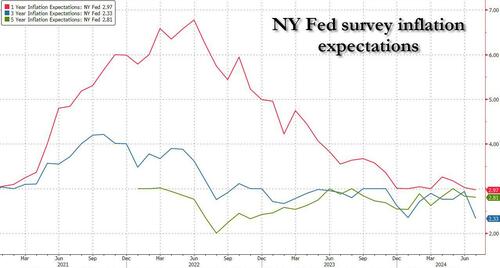
This decline in 3 Year inflation expectations was most pronounced for respondents with a high-school education or less and those with annual household income under $50,000. The survey’s measure of disagreement across respondents (the difference between the 75th and 25th percentile of inflation expectations) decreased at the one- and five-year-ahead horizons and was unchanged at the three-year-ahead horizon.
Extending the inflation outlook,, median home price growth expectations was unchanged at 3.0% in July…
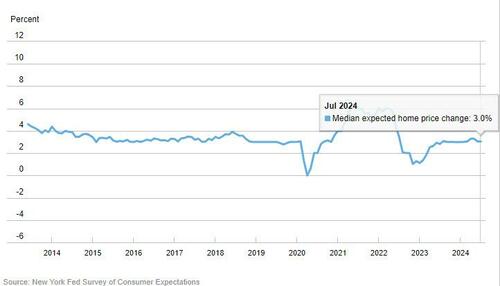
… while year-ahead commodity price expectations declined by 0.8 percentage point for gas to 3.5% and 0.1 percentage point for food to 4.7%, but rose by 0.2 percentage point for the cost of medical care to 7.6%, 1.9 percentage points for the cost of college education to 7.2%, and 0.6 percentage point for rent to 7.1%.
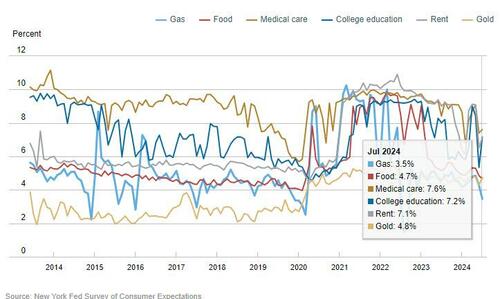
Turning to the labor market, we find that optimism here fizzled as median one-year-ahead expected earnings growth declined by 0.3% point to 2.7% in July. The series has been moving within a narrow range of 2.7-3.0% since January 2024.
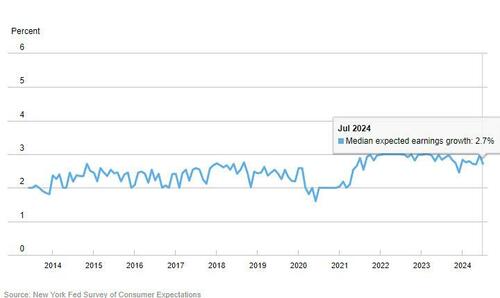
At the same time, mean unemployment expectations, or the mean probability that the U.S. unemployment rate will be higher one year from now, decreased by 1.0 percentage point to 36.6%, remaining below its 12-month trailing average of 37.7%.
One surprise is that according to the survey, the mean perceived probability of losing one’s job in the next 12 months decreased by 0.5% point to 14.3% even though the actual unemployment rate surged last month and triggered the Sahm’s Rule which has preceded every record recession.
Additionally, the mean probability of leaving one’s job voluntarily in the next 12 months increased by 0.2 percentage point to 20.7%, the measure’s highest reading since February 2023. The mean perceived probability of finding a job (if one’s current job was lost) decreased by 0.9 percentage point to 52.5%.
Turning to household finances, the median expected growth in household income was unchanged at 3.0% in Jul…
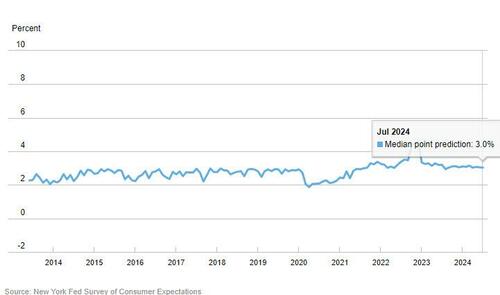
… while median household spending growth expectations fell by 0.2 percentage point to 4.9%, the measure’s lowest reading since April 2021.
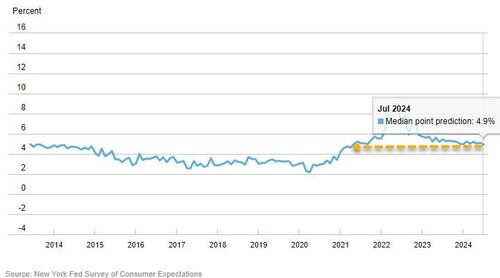
Some more findings:
- Perceptions of credit access compared to a year ago deteriorated in July, with the share of households reporting it is harder to obtain credit than one year ago increasing. However, expectations for future credit availability improved in July, with the share of respondents expecting it will be harder to obtain credit in the year-ahead decreasing.
- Delinquency expectations increased, with the average perceived probability of missing a minimum debt payment over the next three months increasing by 1.0 percentage point to 13.3%, its highest level since April 2020. The increase was most pronounced for those with an annual income below $50,000 and those with a high school degree or less education.
- The median expectation regarding a year-ahead change in taxes (at current income level) declined by 0.3 percentage point to 4.0%. Boy are they going to be surprised.
- Median year-ahead expected growth in government debt was unchanged at 9.3% in July.
- The mean perceived probability that the average interest rate on saving accounts will be higher in 12 months decreased by 0.2 percentage point to 25.1%.
- Perceptions about households’ current financial situations compared to a year ago improved slightly in July, with the share of households reporting a better situation compared to a year ago rising. Conversely, year-ahead expectations about households’ financial situations deteriorated in July, with the share of households expecting a worse financial situation in one year from now rising.
- The mean perceived probability that U.S. stock prices will be higher 12 months from now increased by 0.1 percentage point to 39.3%.
Source: NY Fed
Tyler Durden
Mon, 08/12/2024 – 13:05

 1 rok temu
1 rok temu















